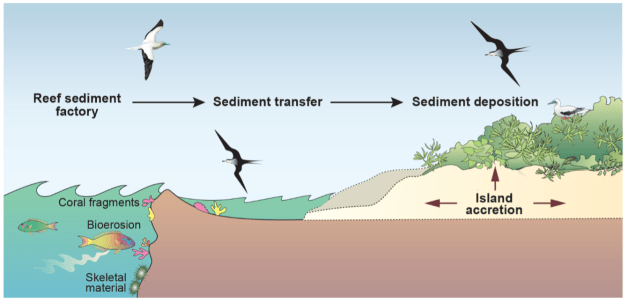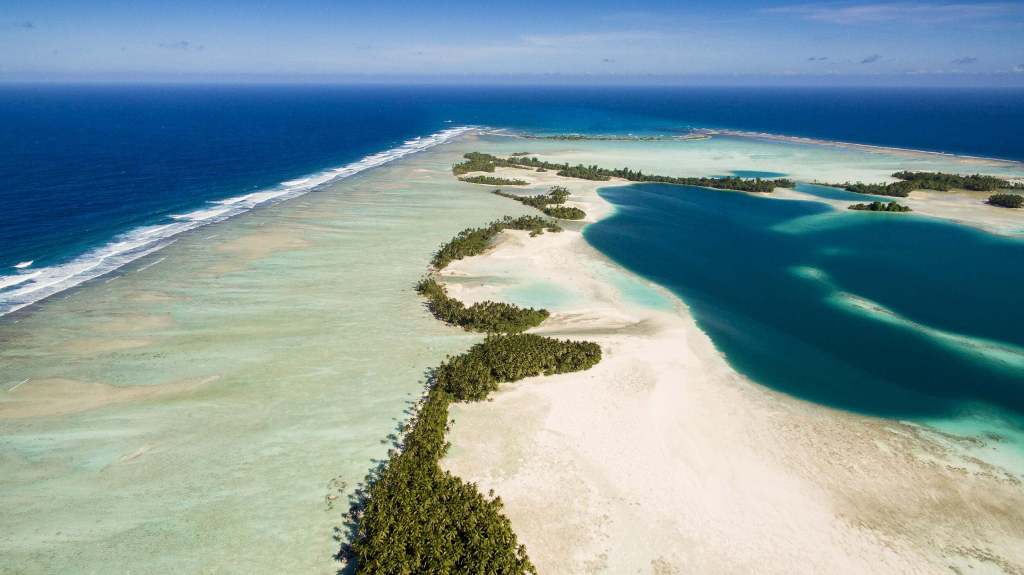An international team of scientists, conservationists, and indigenous leaders argues that strategic ecological restoration could save coral atoll islands from the rising seas of climate change.
The Gist
Published in Trends in Ecology and Evolution, the paper, “Re-thinking atoll futures: local resilience to global challenges” argues that, while climate change is a major threat, the common belief that the world’s atolls will inevitably drown under rising sea levels is dangerously misguided.
In fact, the researchers say, the threat of sea-level rise to atoll islands stems not from their low elevation per se, but because the ecological processes critical to maintaining atoll island accretion—the way atolls grow and change—are increasingly undermined by both global and local human impacts.
“Far from being doomed,” says Sebastian Steibl from the University of Auckland in New Zealand, lead author of the study, “in their natural state most coral atoll islands could adapt to sea level rise. This paper is a global call to identify and quantify the best measures for restoring atoll island growth.”
The Big Picture
Atolls are unique ecosystems that are globally important for a variety of different species, including seabirds and marine turtles, as well as home to numerous Indigenous cultures. Other than volcanic islands like Hawai’i, they are not inert land forms.
The result of complex geological and ecological processes, atoll islands are accumulations of sand- to boulder-size material, generated from surrounding coral reefs, and deposited on coral reef flats by waves and currents. As wave-built structures, most atolls range in elevation 1–5 m above sea level.

Naturally functioning and intact atoll islands can vertically accrete [accumulate sediment] at rates commensurate with sea-level rise (3-10 mm per year), thereby maintaining a groundwater lens that supports life on land. Only when these accretion processes are impaired (by human impacts like deforestation, reef destruction, and the introduction of invasive species), do atoll islands become unable to keep pace with projected sea-level rise.
“Restoration of atoll island ecosystems—like native rainforest restoration and invasive species removal—are proven conservation actions that can significantly improve the health of the surrounding coral reef habitat,” notes Alex Wegmann, an island restoration scientist for The Nature Conservancy in California and co-author. “We’re already testing and proving these restoration methods on existing atolls in the eastern Pacific Ocean, including TNC’s Palmyra Atoll, as well as Tetiaroa, and Aldabra in the western Indian Ocean.”
The Takeaway
While densely populated islands such as in the Maldives will still need human-engineered solutions most coral atoll islands are sparsely inhabited and excellent candidates for ecological restoration.
The climate damage fund announced at COP28 is one potential mechanism for funding local restoration. “Funding restoration work would empower communities to take back ownership of their futures,” says co-author James Russell, a conservation biologist at the University of Auckland.
People living on coral atolls are largely ignored when industrialized nations negotiate responses to climate change.
“Local knowledge alongside cutting edge science needs to be included in atoll restoration programs,” says cultural director of the Tetiaroa Society and co-author Hinano Teavai-Murphy, “because the traditional knowledge of Oceanian people has always been about respecting and preserving the connected marine and terrestrial systems.”
References:
. A global assessment of atoll island planform changes over the past decades. WIREs Clim Change. 2019; 10:e557.



